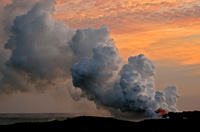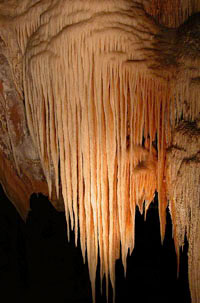
"There's no bismuth like show bismuth" *
Introduction
Welcome to ESS 312. This is one of the growing number of electives in the Earth & Space Sciences 300-level core curriculum. It is a wide-ranging course designed to give you an overview of modern geochemistry - study of the Earth's composition, differentiation, and history, and the high- and low-temperature processes responsible for its past and present evolution. Introductory Chemistry is a pre-requisite for this class, which also builds directly on the mineralogy and petrology you learned in ESS 212.
We begin by reviewing the principles behind bonding, crystal chemistry and element substitution into minerals. It turns out that understanding the simple properties that govern partitioning of elements between partial melts and residual solids, or between gases and condensing solids, leads to some profound conclusions about the composition and history of the Earth. We then move on to a brief review of geochemical thermodynamics - to develop the predictive basis for where and why the Earth melts, why minerals are stable under specific pressure-temperature conditions, and how to calculate the conditions of rock and mineral formation from chemical data. This leads in to a quantitative treatment of trace-element partitioning in magmatic systems, and how we can use trace elements to determine the formation conditions of magmas, the effects of crystallization, and how to recognize kinship between igneous rocks. Finally in the first half of the course we move on to geochronology - the use of long-lived radioisotopes and their daughter products to tell geological time. The same processes of isotopic decay and growth that allow us to date rocks have created isotopic signatures in the crust and mantle, which we can use to trace mixing processes and determine the source of geological materials from tectonic provinces to seawater and volcanic gases.
The second half of the class focuses on low-temperature geochemistry and the Earth's surficial environment. We start with aqueous geochemistry and cover mineral solubility, non-ideal solutions, pH and carbonate equilibria, aluminosilicate weathering, clay minerals, and if time allows, oxidation-reduction reactions. Our treatment of stable isotopes starts by examining why stable isotopes separate between co-existing minerals and fluids, and how we can use this for geothermometry and isotopic labelling. We will look at examples of stable isotope thermometry and isotopic "fingerprints" in the hydrologic and carbon cycles. The course concludes with an overview of geochemical cycles - the interaction between geochemical reservoirs and how we characterise the transfers of elements and chemical compounds from one to another. We will look at the carbon cycle, and see how a couple of man-made tracers - carbon-14 produced by nuclear weapons testing, and carbon dioxide released by fossil fuel burning - can be used to identify the important sinks and sources in the natural carbon cycle, and the uptake and exchange rates between them.
Instructors
John Stone Office: 345 Johnson Hall Phone: 221-6332 stn@u etc
TA: Lab sections AA, AC Addien Wray Office: 432 Johnson Hall awray@u
TA: Lab sections AB, AC Tianyi Huang Office: 423 Johnson Hall tianyih@u Prerequisites
The prerequisites for this course are:
(i) Its ESS precursor ESS 212 (Earth Materials), which provides an introduction to mineralogy and petrology - how, why and where rocks and their constituent minerals form. This class underpins a lot of the teaching in ESS 312, so hang on to your textbook, review your class notes and be prepared to make a very convincing case if you want this pre-requisite waived.
(ii) A good grounding in basic chemistry: CHEM 142 (General Chemistry) or higher. We will review a few essentials along the way, but knowledge of atomic theory, stoichiometry, energetics (introductory thermodynamics), acid-base theory and the concept of chemical equilibrium will be assumed.
(iii) Mathematics up to and including integral calculus. The options are: MATH 125 (Calculus with Analytic Geometry II), or Q SCI 292 (Analysis for Biologists II). You will need basic integral calculus to handle lectures and problems in thermodynamics. Simple differential equations will turn up in the treatment of radioactivity and geochronology, chemical kinetics, and especially in the treatment of geochemical cycles.
Class Timetable
Lecture 11:30 - 12:20 M W F 175 Johnson Hall Lab AA 10:30 - 12:20 T Th 021 Johnson Hall Lab AB 08:30 - 10:20 T Th 021 Johnson Hall Lab AC 15:30 - 17:20 W F 021 Johnson Hall Many of the lab exercises are computer-based. In some of them we will use Microsoft EXCEL spreadsheets to build simple models of geochemical systems and processes, such as crystallization in magma chambers or depletion of the mantle to form the crust and atmosphere. If you haven't used EXCEL to do calculations, solve equations or build interactive graphs, be sure to talk to an instructor early in the quarter. By the end of the course you will be an expert.
Textbooks and recommended reading
The topics in this class aren't covered evenly in any single textbook, and due to absurd prices, we don't recommend buying more than one. Hence there is no required text for the class, but you may find one of the following useful. The most comprehensive book, with the best set of practice problems, but by far the most expensive, is by Faure: Principles and Applications of Geochemistry. This provides pretty good coverage of most of the topics in the syllabus.
Another option is: "Geochemistry: Pathways and Processes" by McSween, Richardson and Uhle (2nd edition, 2003), published by Columbia University Press.
In the past we've used Geochemistry by Brownlow, which covers some of the same material, but deals too thinly with other important areas.
You can find these at the UW Bookstore, or look for cheaper used copies online at Powell's Books, ABE Books, Amazon or elsewhere. [No - sadly these are not sponsored links].
Syllabus and lab schedule
There is a summary of lecture topics and suggested reading on the 2015 introductory handout and syllabus distributed in class on day 1.
Please also read and understand College and ESS policies on student conduct and disability accomodations as they apply to this class.
More details on the lecture handouts download page.
Lab topics, schedule and due-dates are listed on the lab materials download page.
Exams and grading policyExams will cover material presented in lectures and labs. Exam questions will emphasize concepts and problem-solving rather than memorization. The final exam will be comprehensive, but it will deal mostly with material covered after the mid-term exam.
Midterm exam 25% of your final grade Final exam 35% of your final grade Tuesday 9 June 8:30 - 10:20 am Lab assignments 40% of your final grade Due dates on the lab schedule



